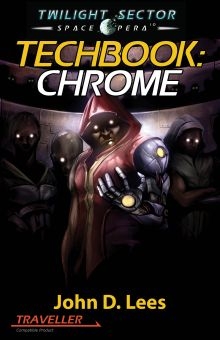Techbook: Chrome
This article originally appeared in the November/December 2012 issue.
 Techbook:
Chrome. John Lees.
Techbook:
Chrome. John Lees.
Terra/Sol Games http://www.terrasolgames.com
136pp, PDF
US$8.99
Techbook: Chrome is an OGL supplement for the Mongoose version of the Traveller RPG; it is published by Terra/Sol Games, the producers of the Twilight Sector setting book. The book is written by John D. Lees with interior art by Emel Akiah, John Lees and Jeff Uryasz; the cover art is by Phillip Simpson. As the book states, it is “An alternative take on cybernetics, with rules for bionics and other bio-replacements, cyborgs and cyrgeware thrown in for good measure.”
Interestingly enough, on the back cover, in one place, the book is referred to as Techbook: Implants.
The artwork is primarily black and white pencil drawings with some simple computer-generated color artwork by John Lees. The color artwork is a bit jarring, both in its simplicity and that fact that these six pictures are the only color art in the entire book, but overall, the art does a good job of illustrating the text it is tied to and continues the semi-Space Opera feel of the Twilight Sector setting.
Texbook: Chrome is in many ways similar to Mongoose Publishing’s Supplement 8: Cybernetics. However, I feel that the options provided in Chrome are better organized and better thought out than the information provided in Cybernetics. Both books cover a wide range of cybernetic implants, but where Cybernetics handled biological/bionics with a few sentences, Chrome spends thirteen pages discussing biological replacements and bionic upgrades.
Chrome spends quite a bit of time discussing the advantages and disadvantages of cyber vs. biological implants. This reasoning makes sense and provides both players and referees with in-game reasons for selecting either cyber or biological replacements or upgrades.
Additionally, Chrome provides several “packages”, groups of upgrades that work together to provide a certain desired result. Sample packages are the “sportsman” and the “allure” packages. The drawback to this excellent chapter is that there were no rules or guidelines for Referees to develop their own packages.
One of the complaints of Cybernetics when it came out was that the costs were out of alignment with the costs listed in the core rulebook. In a side-by-side comparison of the three books, I found that the costs between Chrome and the Traveller Core Rulebook were close on some things (skills and vision) but very different on others (characteristic upgrades and subdermal armor). Chrome was much cheaper on limb replacement than was Cybernetics and I personally agreed with the Chrome values.
The last area where Chrome is different from Cybernetics is the discussion of ‘cyrgeware’. Cyrgeware is a high tech way for characters to slowly alter their physical forms. In game terms, a character can vary the physical characteristics, and appearance, of their character on an ‘as needed’ basis. It isn’t cheap and it isn’t perfect, but it is a way for a character to grow an extra limb when needed, or add a tail for a while.
Overall, I felt that Techbook: Chrome presented the material of cybernetic and biological augmentation in a much easier to read format and covered each topic a bit more in-depth than the material covered in Mongoose’s Supplement 8: Cybernetics. I also felt that the ideas within Techbook: Chrome were better integrated with each other than those of Supplement 8: Cybernetics.
Rating: 4 out of 5 Stars
 Freelance
Traveller
Freelance
Traveller